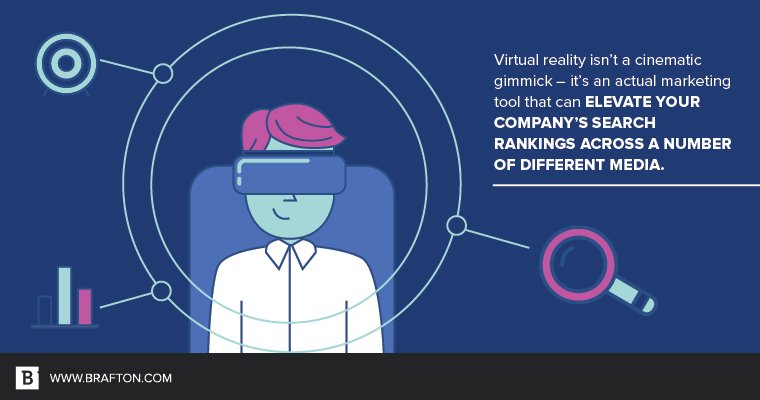Let’s take a step back from video games and have a serious discussion about virtual reality.
*unstraps headset and puts down controller*
Virtual reality is still in its infancy yet has been preordained as a new frontier for marketers everywhere. Just think, you’re able to provide a fully immersive, interactive experience for your audience and reach them from the convenience of their couches. What’s better than that?
In the real world, however, VR marketing success is still years away – at least at a significant scale for the average company. But that doesn’t mean you’re doing yourself any favors by letting the VR craze grow stronger without you. Plus, the potential results you forgo may be leveraged by competitors bent on beating you to the punch.
Consider this: 53 percent of consumers say they’re more likely to purchase from a company that uses VR versus those that don’t. And 71 percent think VR makes brands more forward-thinking.
Upon watching a video about VR for the first time, 58 percent stated they were “amazed” – a clear indicator that virtual reality is on the precipice of overhauling the means with which brands and customers interact.
Industries primed to benefit most from VR
It’s difficult to claim virtual reality marketing will impact all companies equally – in fact, many businesses may experience little disruption.
Brafton Senior Creative Director Perry Leenhouts said that VR is less applicable in terms of marketing physical products or software – it’s unlikely a customer will gain any additional value from (virtually) crawling inside a coffee mug or a database (unless you’re, like, into that kind of stuff).
“VR is the experience of the viewer,” Perry said. “Product-specific marketing doesn’t translate as well into a virtual world where viewers are most likely to want a complete experiential adventure.”
So what industries are geared for a heavy dose of VR?
At the moment, the gaming industry is clearly No. 1. Beyond that, Perry noted the travel, hospitality and entertainment sectors are beginning to experiment more with VR capabilities.
And it makes sense – these are business models that rely upon multisensory commitments from the customer (riding an airplane, sleeping in a hotel bed, listening to live music, etc).
Other emerging VR benefactors are real estate companies and heavy-duty, space-intensive commercial operations.
Imagine how practical it would be for a large-scale equipment manufacturer to use VR for employee safety exercises. Or, envision an oil and gas facility needing offshore, underwater videos that spotlight hazards or what it might take for a worker to conduct maintenance on a rig.
If used effectively, these types of companies could theoretically reduce costs related to injury and downtime. Further, VR could be marketed externally to prospective business partners in the form of visually showcasing the benefits of working with them.
Why VR is critical to the SEO of the future
Virtual reality isn’t a cinematic gimmick – it’s an actual marketing tool that can elevate your company’s search rankings across a number of different media.
“This isn’t 3-D TV or Smell-O-Vision,” Perry said. “This is a revolution.”
Last year, Google made VR videos and images optimizable for organic search directly through mobile and desktop. This means viewers don’t necessarily need native apps or branded headsets – they can still experience VR through their normal channels.
Additionally, there is inherent SEO value in optimizing VR.

Content quality is ranked as one of the top factors Google’s algorithms prioritize when displaying search results. And VR content has already proven to be extremely effective in driving metrics that signal strong, quality content, such as:
- Time on page.
- Engagement.
- Shares.
- Views.
- Interactions.
- Subscriptions.
- Empathy.
While some firms may not be able to invest in a full-throttle VR strategy due to technical, equipment or production limitations, virtual reality filming is not all that difficult to learn. In fact, most professional videographers have some level of experience with similar camera setups and already know the ropes of stitching together 360-degree panoramic shots.
“People are getting used to producing and experiencing VR,” Perry said. “And the more it catches on, the faster it grows because there is more money to be made in it.”
VR staying power
As consumer-based VR products like Google Cardboard and Oculus Rift evangelize a generation of experiential enthusiasts, VR marketing will become second nature to viewers and marketers alike. Not to mention, augmented reality (AR) has enjoyed tremendous popularity in the form of Pokemon GO, eBay’s “Shoptical” and IKEA’s AR product catalog.
SEO specialists, video production companies and content creators will likewise have to update their proficiencies to ensure they’re fully capitalizing on VR potential – and providing their clients with the proper expertise. This general evolution toward a new marketing norm – a virtual world – will be gradual for most brands.
But are you looking for explosive results or just gradual results?
The answer to this question determines how much you’re willing to invest in VR and how quickly you’re looking to outpace competitor martech.
Two recent VR success trends:
- Colleges that utilize virtual campus tours have seen a 30 percent uptick in the number of requests for physical visits.
- The United Nations’ first foray into VR helped double the number of its campaign donors, and the dollar amount of each donation rose 18 percent on average. The UN’s visual marketing campaign brought in $1 billion more than expected.
These ROI wins may not be 100 percent transferrable to your business, but whose to say that in the next decade they won’t be?





